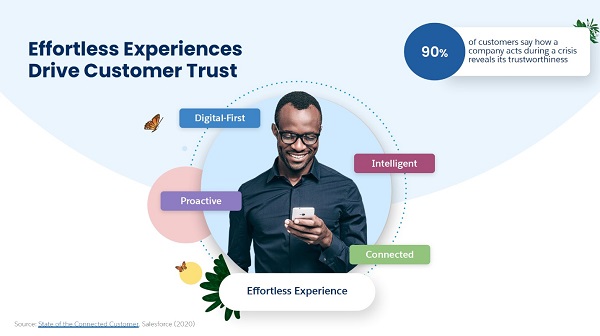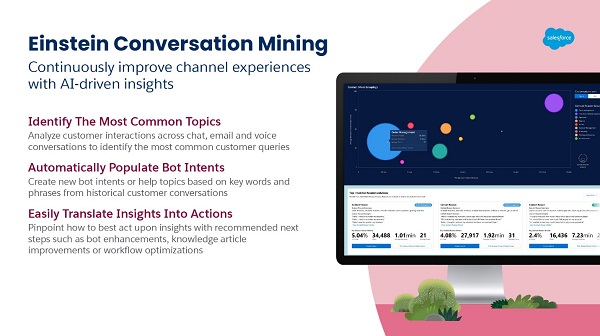Salesforce today
announced it is adding new AI-powered automation and digital channel innovations to Service Cloud 360. Salesforce’s annual user and partner event,
Dreamforce, is being held virtually in two weeks — with its kaleidoscope of product, service, and partner news. Think of today’s announcement as the company’s opportunity to shine a light on the array of functionality being added to Salesforce Service Cloud, all with the theme of helping organizations create effortless experiences through fast and proactive service that build trust and loyalty with customers.
What role can AI play in creating effortless experiences? Matt Dixon, author of the definitive book 2013 on CES,
The Effortless Experience: Conquering the New Battleground for Customer Loyalty, has been touting the value of AI to gather effort score data in lieu of traditional customer surveys in speaking engagements in 2021. In addition, AI in service delivery offers a modern lens to think about reducing customer effort by adding automation to the process.
Two weeks ago, one element of this announcement was discussed during a Salesforce event centered on the notion of creating a digital headquarters.
Meet Slack-First Service from Salesforce highlighted case swarming. Here, I will explore another of the concepts that incorporates the elements of an effortless experience shown in the graphic — incident management.
Salesforce describes
customer service incident management as automatically connecting multiple service cases on the same issue or incident — like a mass power outage — enabling incident response teams to better classify and prioritize which incidents to resolve first based on impact and urgency. This allows teams to track and fix issues before they impact customers. Integrations with existing incident systems for IT systems and cloud software, e.g.,
Datadog and
PagerDuty, enable real-time monitoring and service status to provide a holistic, proactive incident management solution.
As
Gautam Vasudev, VP, product management of Salesforce, was describing incident management to me during a pre-briefing, I thought back to an event early in my telecommunications career, the 1982 Tylenol scare. As part of an AT&T national account team at the time, I witnessed first-hand how the communications needs of Tylenol manufacturer Johnson and Johnson became an all-hands-on-deck concern for AT&T. Similar to how COVID pushed the customer service needs of companies beyond any reasonable planned surge level, millions of Tylenol users were told — by the media — not to consume any Tylenol products, and they contacted Johnson and Johnson en masse. The strategies to handle these primarily phone interactions were being created and deployed on the fly.
Salesforce describes these attributes of incident management, helping to resolve issues faster and build customer trust in the moments that matter most:
- Streamline service operations — Salesforce empowers service and operations teams to work in harmony with a cloud-based, digital information, and service environment. In this way, everyone has visibility into the incident, case information, and customer data in a unified, collaborative workspace.
- Proactively address major disruptions — Admins can monitor external systems to identify issues before the broader impact occurs. The ability to speed up incident detection with AI and surface solutions from similar, earlier problems is particularly impactful.
- Swarm on incidents with Slack — Users can connect to the right experts across internal and external teams to quickly diagnose and problem-solve major incidents and escalations.
- Keep customers informed — Incident management supports keeping customers informed with real-time status updates or workarounds on digital channels (web, messaging, email, in-app, social, etc.). This is an important ingredient to increase transparency and build trust with customers.
- Einstein conversation mining — This new AI feature supports incident detection and other use cases. The feature assists in new intents conversion and creation or can automate help topics based on historical customer conversations.
While there is a space of 40 years between the Tylenol scare and COVID, most companies were as woefully unprepared for the customer service implications of COVID in 2020 as one company was in 1982. Salesforce worked tirelessly in the beginning of 2020 to help companies with quick solutions to the issues created by COVID. I see Salesforce’s highlighting of customer service
incident management as a thoughtful look at how to help companies put systems in place today to address similar problems in the future.











